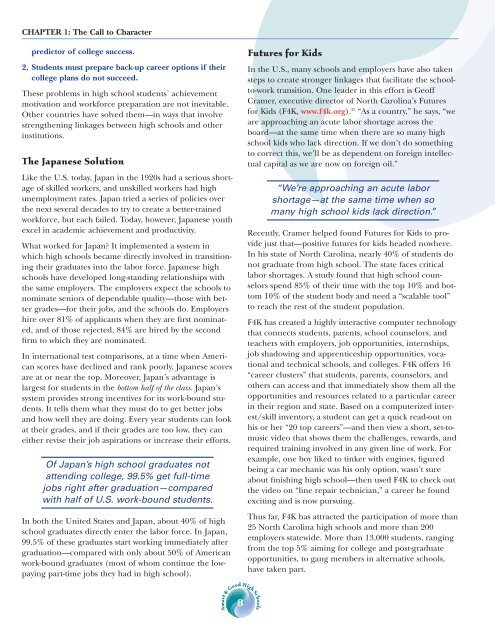Smart & Good High Schools - The Flippen Group
Smart & Good High Schools - The Flippen Group
Smart & Good High Schools - The Flippen Group
- No tags were found...
You also want an ePaper? Increase the reach of your titles
YUMPU automatically turns print PDFs into web optimized ePapers that Google loves.
CHAPTER 1: <strong>The</strong> Call to Characterpredictor of college success.2. Students must prepare back-up career options if theircollege plans do not succeed.<strong>The</strong>se problems in high school students’ achievementmotivation and workforce preparation are not inevitable.Other countries have solved them—in ways that involvestrengthening linkages between high schools and otherinstitutions.<strong>The</strong> Japanese SolutionLike the U.S. today, Japan in the 1920s had a serious shortageof skilled workers, and unskilled workers had highunemployment rates. Japan tried a series of policies overthe next several decades to try to create a better-trainedworkforce, but each failed. Today, however, Japanese youthexcel in academic achievement and productivity.What worked for Japan? It implemented a system inwhich high schools became directly involved in transitioningtheir graduates into the labor force. Japanese highschools have developed long-standing relationships withthe same employers. <strong>The</strong> employers expect the schools tonominate seniors of dependable quality—those with bettergrades—for their jobs, and the schools do. Employershire over 81% of applicants when they are first nominated,and of those rejected, 84% are hired by the secondfirm to which they are nominated.In international test comparisons, at a time when Americanscores have declined and rank poorly, Japanese scoresare at or near the top. Moreover, Japan’s advantage islargest for students in the bottom half of the class. Japan’ssystem provides strong incentives for its work-bound students.It tells them what they must do to get better jobsand how well they are doing. Every year students can lookat their grades, and if their grades are too low, they caneither revise their job aspirations or increase their efforts.Of Japan’s high school graduates notattending college, 99.5% get full-timejobs right after graduation—comparedwith half of U.S. work-bound students.In both the United States and Japan, about 40% of highschool graduates directly enter the labor force. In Japan,99.5% of these graduates start working immediately aftergraduation—compared with only about 50% of Americanwork-bound graduates (most of whom continue the lowpayingpart-time jobs they had in high school).Futures for KidsIn the U.S., many schools and employers have also takensteps to create stronger linkages that facilitate the schoolto-worktransition. One leader in this effort is GeoffCramer, executive director of North Carolina’s Futuresfor Kids (F4K, www.f4k.org). 35 “As a country,” he says, “weare approaching an acute labor shortage across theboard—at the same time when there are so many highschool kids who lack direction. If we don’t do somethingto correct this, we’ll be as dependent on foreign intellectualcapital as we are now on foreign oil.”“We’re approaching an acute laborshortage—at the same time when somany high school kids lack direction.”Recently, Cramer helped found Futures for Kids to providejust that—positive futures for kids headed nowhere.In his state of North Carolina, nearly 40% of students donot graduate from high school. <strong>The</strong> state faces criticallabor shortages. A study found that high school counselorsspend 85% of their time with the top 10% and bottom10% of the student body and need a “scalable tool”to reach the rest of the student population.F4K has created a highly interactive computer technologythat connects students, parents, school counselors, andteachers with employers, job opportunities, internships,job shadowing and apprenticeship opportunities, vocationaland technical schools, and colleges. F4K offers 16“career clusters” that students, parents, counselors, andothers can access and that immediately show them all theopportunities and resources related to a particular careerin their region and state. Based on a computerized interest/skillinventory, a student can get a quick read-out onhis or her “20 top careers”—and then view a short, set-tomusicvideo that shows them the challenges, rewards, andrequired training involved in any given line of work. Forexample, one boy liked to tinker with engines, figuredbeing a car mechanic was his only option, wasn’t sureabout finishing high school—then used F4K to check outthe video on “line repair technician,” a career he foundexciting and is now pursuing.Thus far, F4K has attracted the participation of more than25 North Carolina high schools and more than 200employers statewide. More than 13,000 students, rangingfrom the top 5% aiming for college and post-graduateopportunities, to gang members in alternative schools,have taken part.8<strong>Smart</strong> & <strong>Good</strong> <strong>High</strong> <strong>Schools</strong>















